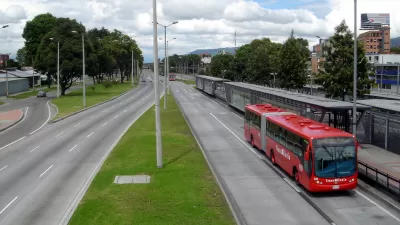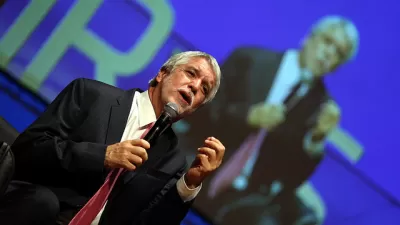It may not be sexy and it may not be fast, but the time has come to acknowledge the key role that the much maligned form of public transit will have in solving cities’ mobility woes, writes Will Doig.
Less expensive and easier to implement than rail-based mass transit, Doig looks to bus rapid transit as a system with the potential to revolutionize mobility in U.S. cities, as it has across the world, from Bogotá to Guangzhou.
According to Doig, "[m]aking people like the bus when not liking the bus is practically an American pastime essentially means making the bus act and feel more like a train. Trains show up roughly when they're supposed to. Buses take forever, then arrive two at a time. Trains boast better design, speed, shelters, schedules and easier-to-follow routes. When people say they don't like the bus but they do like the train, what they really mean is they like those perks the train offers. But there's no reason bus systems can't simply incorporate most of them."
Doig, with the assistance of transit consultant Jarrett Walker, offers some relatively easy fixes to vastly improve the image and functionality of bus systems anywhere, including increasing frequency, improving bus maps, enhancing predictability, upgrading bus stops, and raising the aesthetics of the buses themselves.
FULL STORY: It’s time to love the bus

Maui's Vacation Rental Debate Turns Ugly
Verbal attacks, misinformation campaigns and fistfights plague a high-stakes debate to convert thousands of vacation rentals into long-term housing.

Planetizen Federal Action Tracker
A weekly monitor of how Trump’s orders and actions are impacting planners and planning in America.

Chicago’s Ghost Rails
Just beneath the surface of the modern city lie the remnants of its expansive early 20th-century streetcar system.

Bend, Oregon Zoning Reforms Prioritize Small-Scale Housing
The city altered its zoning code to allow multi-family housing and eliminated parking mandates citywide.

Amtrak Cutting Jobs, Funding to High-Speed Rail
The agency plans to cut 10 percent of its workforce and has confirmed it will not fund new high-speed rail projects.

LA Denies Basic Services to Unhoused Residents
The city has repeatedly failed to respond to requests for trash pickup at encampment sites, and eliminated a program that provided mobile showers and toilets.
Urban Design for Planners 1: Software Tools
This six-course series explores essential urban design concepts using open source software and equips planners with the tools they need to participate fully in the urban design process.
Planning for Universal Design
Learn the tools for implementing Universal Design in planning regulations.
planning NEXT
Appalachian Highlands Housing Partners
Mpact (founded as Rail~Volution)
City of Camden Redevelopment Agency
City of Astoria
City of Portland
City of Laramie





























